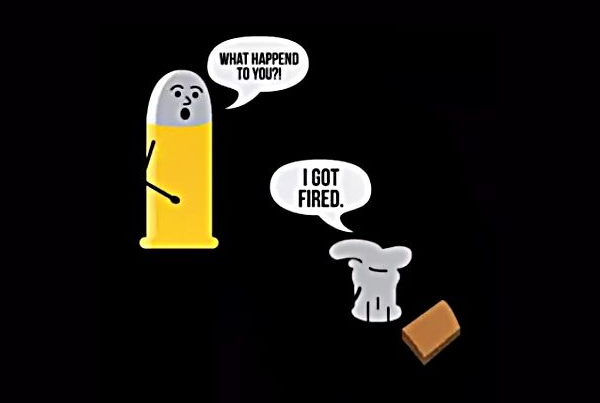Copywriting is the art of crafting messages that bring home the bacon. The bread.
Or as Slough’s finest paper company manager would say…
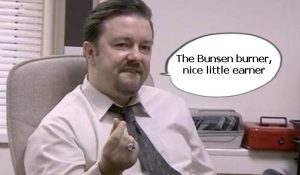
As with any artistic pursuit – learning to paint, play an instrument, pen a sonnet – some people are all-naturals. While the rest of us start out preservative-free, at best.
The secret to effective copy isn’t creative genius
You don’t need to be the Leo DaVinci, Jimi Hendrix or Billy Shakespeare of content to write copy that catches eyes, seduces minds and finds wads of cash left on the bedside table in the morning.
Armed with the right knowledge, and enough practice, almost anyone can become a highly proficient copywriter. Even a great one.
Here’s what copywriting is all about
To create powerful copy you must first speak with, listen to and learn from your audience.
Unless you know a good Russian hacker, it’s the only way to deeply understand people’s unique desires and problems.
Armed with this insight, you’ll be well-equipped to:
• capture your audience’s attention during their busy lives
• keep them curious and interested enough to read on
• encourage them to take action.
But you can’t just get up in people’s faces with an infomercial and expect them to buy.
Not on your first date. They’ll run a mile.
Unless you’re selling $15 teeth.
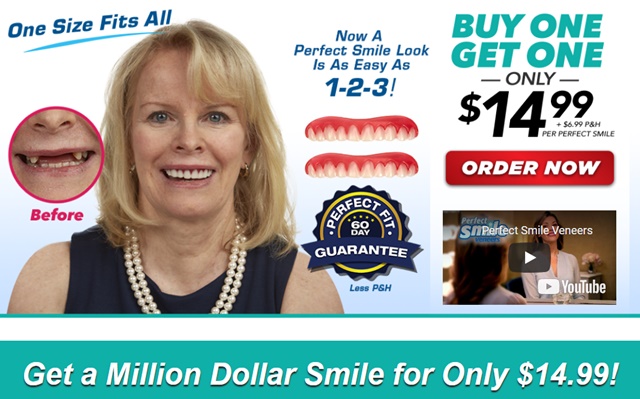 For the most part, people want to be in control of their copy conversation – and feel like they’re making decisions to buy or take action after sound consideration.
For the most part, people want to be in control of their copy conversation – and feel like they’re making decisions to buy or take action after sound consideration.
That’s why good copywriting techniques are invaluable sales tools. They help you:
- answer prospect’s questions
- allay their concerns
- show that you understand their needs and dreams.
Once you’ve had that helpful and empathetic conversation on the page, readers will feel more confident about buying, calling or joining.
Whether you throw in a free set of dentures, steak knives, or not.
7 copy tactics to charm the pixels off your prospects
Apply these techniques to your website copy, emails, social posts and blog posts. Heck, use them in you print copy and Tinder profile too.
They’ll all help make your messages more appealing, intriguing and convert-alicious.
Shine the spotlight on your benefits
Cold, hard truth No.1: Potential customers don’t care about your business, product or service – unless they can see how it helps them.
So, don’t start your conversation off boring them with details about who you are and what you do.
Paint a real-life picture of how you’ll solve their problems, ease their pain and help them achieve their goals and dreams.
It might be to:
• make them wealthier, healthier or more attractive
• save them time, effort or stress
• improve their self-confidence, mood or love life.
Be as specific as possible.
Talk about the money they’ll have to buy that house by the beach with the hammock swinging on the deck.
Or the freedom they’ll have with the time you save them – whether it’s to invest in growing their business, enjoying family holidays or something else they see as invaluable.
Or invite them to imagine how it will feel to wake up from the deep, blissful sleep they’ve been missing for years – refreshed, perky and pain-free.
Make your readers feel something
Emotions are the result of chemicals being released by our brains. For example:
- dopamine (you feel happy)
- serotonin (you feel confident, proud and recognised)
- cortisole (you feel stressed)
- oxytocin (you feel empathetic or in love)
- endophin (you feel euphoria to overcome pain)
These sensations make us want to act in certain ways, such as:
- When we’re happy, we want to share.
- When we’re sad, we want to connect and understand.
- When we’re angry, we become stubborn (but not me).
- When we’re scared, we want to cling onto something so we don’t lose it.
We’ve already discussed one technique that gives audiences the feels – highlighting relevant and specific benefits.
Here are a few more.
Address your audience’s pain
If you really want to pique people’s interest with your copy, mention their problem, or pain-point, as a lead into your benefits.
You can turn up the heat even more by including emotive words that your readers would use to describe how they’re feeling e.g. frustrated, worried, struggling, etc.
Problem: Are you embarrassed by your acne?
Benefit: Our clinically-proven ZitZapper works deep inside pores to eliminate blemishes, make your skin smooth and give you back the confidence you’ve been missing.
You can also combine pain-points and benefits in a nifty copywriting technique called:
Problem – Agitate – Solve (PAS)
Problem: Are you embarrassed by your acne?
Agitate (sprinkle some salt on the wound): Do you worry that it’s having an impact on your work and social life?
Solve/Benefit: Our clinically-proven ZitZapper works deep inside pores to eliminate blemishes, make your skin smooth and give you back the confidence you’ve been missing.
Here’s another example of P.A.S. that has nothing to do with teeth, skin or any other body part.
Problem: When was the last time you finished everything on your daily to-do list? (Note: you’d only use an open question like this as the ‘problem/pain’ if you know that your audience is super-busy or has time-management issues)
Agitate: If you’re like most small business owners, you’re constantly struggling to stay on top of everything – let alone be the leader that your team need right now.
Solve: FindTime software helps hundreds of busy Australian bosses slash 10 or more hours a week off admin tasks. That’s invaluable extra time you could be investing in the success of your business and people. Contact us today for a free demo and trial.
Tell a compelling story
Powerful stories make business messages easier for customers to understand and remember. They can also turn your brain into a chemical soup of emotion.
Plus, MRI scans show that when people read a captivating story their bodies and brains react as if they’re living out the scene. That’s kind of freaky, but definitely worth exploiting.
So, tell a captivating story that your readers can relate to. It could be about:
- you, a staff member or your business
- a customer or anyone you help
- your product or service.
Stories don’t need to be long. They just need to be relevant and moving.
Feeding America combine bite-sized morsels of copy with evocative images to share powerful stories on their social pages.
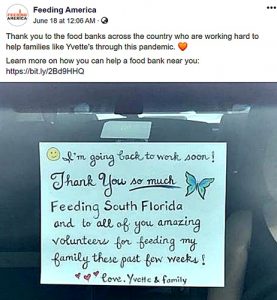 Make people smile
Make people smile
Humour is potent emotional content. It’s unexpected and can quickly make readers feel that your business is fun to be around.
The best part? Your product or service doesn’t need to be fun for your copy to be funny.
Dollar Shave Club did it for razors. Lloyd’s of London often do it for insurance.
Water Safety NZ did it to stop men without fully developed brains from drowning. Their Swim Reaper campaign worked a treat.
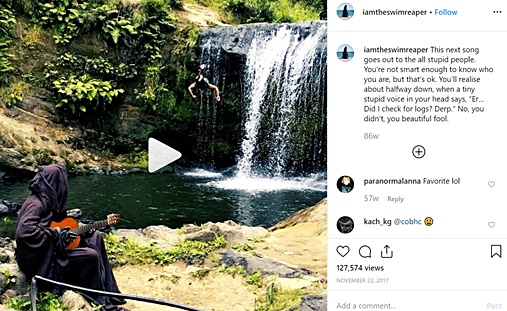
Tread carefully with humour, because it’s a highly subjective word:
- Ask yourself – Is funny is the best way to achieve our objective?
- Don’t overdo the jokes – clarity before comedy
- Get someone to read your copy – to ensure that it’s understandable, amusing and achieves your goal.
Intrigued by all this emo stuff? Then you might like to dive deeper and check out a few more techniques and examples in my post on the Irresistible Power of Emotional Content
Create a show-stopper headline
Your headline is the first message most visitors read on your web page, social post, blog or email (or the subject line in you inbox).
Think of it as your helpful sales star greeting customers at the door. Your maître de. Your Lionel Ritchie.

But your headline can’t just try to look as smooth as Lionel. It has three jobs to perform for your audience:
• Tell them what the content is about.
• Make them feel it would be beneficial to read on.
• Draw their eyes to the first line of text below.
A decent headline masters two of these duties. The most powerful ones nail all three.
If your headline doesn’t perform any of the above, people will leave.
You should fire that headline.
Let’s do a headline performance review
Here’s one from a government website. The page provides information on how to help a friend or family member give up smoking.

Support who? Quit what? Quit leaning on me, that’s what!
Hmm, time to interview some new headlines.

Ahh, that’s a little better. Now I get what you’re talking about.
But I don’t immediately feel that you’re speaking to me. We’ll be in touch.

Now, you’re definitely addressing me. And I’ll probably read on because ‘How to’ suggests you provide the answer.
Plus, you pulled my heartstrings by throwing in ‘Loved One’.
You don’t play fair. When can you start?

It’s clear what you’re about, and the subhead quickly confirms who the content is for.
By including ‘Do’s and Dont’s’ you also piqued my curiosity – and fear. Now I’m going to have to read on to make sure that I don’t stuff up and let down my smoker.
That was cruel, yet clever. You got yourself a job, kid.
There are gazillions of effective headline techniques
To kick you off, here are eight headline templates you can adapt to your own needs:
• How to – How to get out of debt no matter how much you owe
• Question – Do you suffer from aching joints in the morning?
• News – Introducing Havana-rock: the best music you’ve never heard of
• Lists/numbers – 7 ways to conquer your fear of presenting to a crowd
• Brackets – How to look super-confident (even when you’re sweating bullets)
• Fear – The unseen dangers of sport and energy drinks
• Negative superlative – The worst social media marketing fails of 2019
• Urgency – Limited Edition Polo Shirts. 25% Discount Expires Tonight!
Open with a conversation starter
I can see that you’re feeling chuffed because your attention-grabbing headline just hit the sweet spot.
What now?
People’s eyes are heading down to your opening sentence, that’s what.
This is where your copy can make it, or break it. Lose the audience here and it’s adios forever, amigo.
No pressure, of course.
How do you hold on to and build reader interest and curiosity? Bring them into the conversation from line one.
Here are three opening sentence techniques to try:
Ask a question that gets them nodding/emotional
Example: Are your online shoppers leaving before they buy? Are you losing precious profits at checkout?
Get them thinking/Make them curious
Example: It’s the new year, and diet programs are selling hard on the promise of a new you. Should you bite?
Another example: If you’re thinking about buying a home, first ask yourself this one critical question.
Paint a picture
Example: Imagine whisking down a powdery, snow-covered mountain in Aspen. And at the end of the day, relaxing in your luxurious 5-star lodge – at up to 60% off!”
Almost any business could start a web page, email or social post inviting people to ‘Imagine…’ or ‘Picture yourself…’ doing something fun or beneficial.
And it’s just as effective if you want your audience to empathise with others, or imagine themselves in a difficult situation.
For example, on a charity site supporting people who are visually impaired you could begin your body copy with…
Imagine if you couldn’t read these words.
Feed your readers snack-sized morsels of goodness
Most people don’t read every word of copy. They usually check out the headline and make decisions from there.
If the headline hits the spot, they’ll probably read that smoldering opening sentence you just penned. Maybe stay glued for a couple of paragraphs.
Then their eyes will start to flick down and around the page, like a ricocheting pinball on the hunt for flashing targets.
If your page is a wall of morbidly obese paragraphs, readers won’t take it on.
Even three-line paragraphs can seem like a bother. Especially on mobile screens where three lines become six, and four become eight.

Before a word is published, make your marketing messages inviting eye-candy by:
• including descriptive subheads
• using short paragraphs
• leaving plenty of white space
• turning long sentences into bullet points (see what I did here?).
Use the minimum words needed (by your audience)
When it comes to copy, shorter is better. But what does short copy mean?
If you’re selling high-priced or complex products and services, you’ll probably need to include more words on the page than if you’re selling cheap and simple ones.
That’s because people usually need more questions answered before they’ll commit to an expensive or complicated offer.
However, there are exceptions to the rule…

But this Aston Martin car salesman is still going to need to answer plenty of questions before any blissfully married millionaires hand over their Platinum card and a juicy commission.
Rather than think of short copy, aim for the minimum words necessary to:
- get your most persuasive message across
- avoid leaving prospects confused, wary or unable make decisions.
If you’re worried about having too much copy on the page, you can hide extra information in an accordion dropdown.
Here’s an accordion drop-down example from one of my web writing training pages.
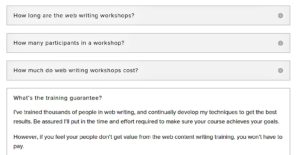
Accordions help make your page look tasty enough for impatient people to devour. At the same time, curious prospects can still click to get extra questions answered quickly.
Once you’ve written your draft copy, read over it and:
- try to keep most sentences to 15 words or less
- avoid industry slang (unless your whole audience understand and appreciate it)
- drop words that don’t add useful information.
Bring it all home with a convincing call to action
Once people get to the end of your content, don’t assume they know what to do next.
Even if prospects like what they hear, they may not act without some clear directions.
Use action verbs
Tell them to buy now, learn how, get your, contact, add to cart, visit us, join today, etc.
Push them over the edge
Your best chance to get someone’s business is while they’re hot for what you got.
Encourage your audience to act now by mentioning:
- a limited time offer (even add a countdown clock)
- there are only X number available
- you’ll save X% today
- how easy it is (e.g. only takes 2 minutes)
- a benefit (e.g. Get your x, Start sleeping soundly tonight)
- there’s no risk (e.g. a money back guarantee, 30-day trial)
Great copywriting isn’t something you can master from one blog post. Or in one year.
Why not? Because knowledge is only part of the puzzle.
You’ll gain so much more from the experience of writing copy – every win and every fail.
However, understanding these seven techniques puts you well ahead of the business writing pack.
Use them today, tomorrow and every time you write content.
They’ll help you create more enticing, engaging and persuasive business messages that bring in those Bunsen burners, much bigger earners.



